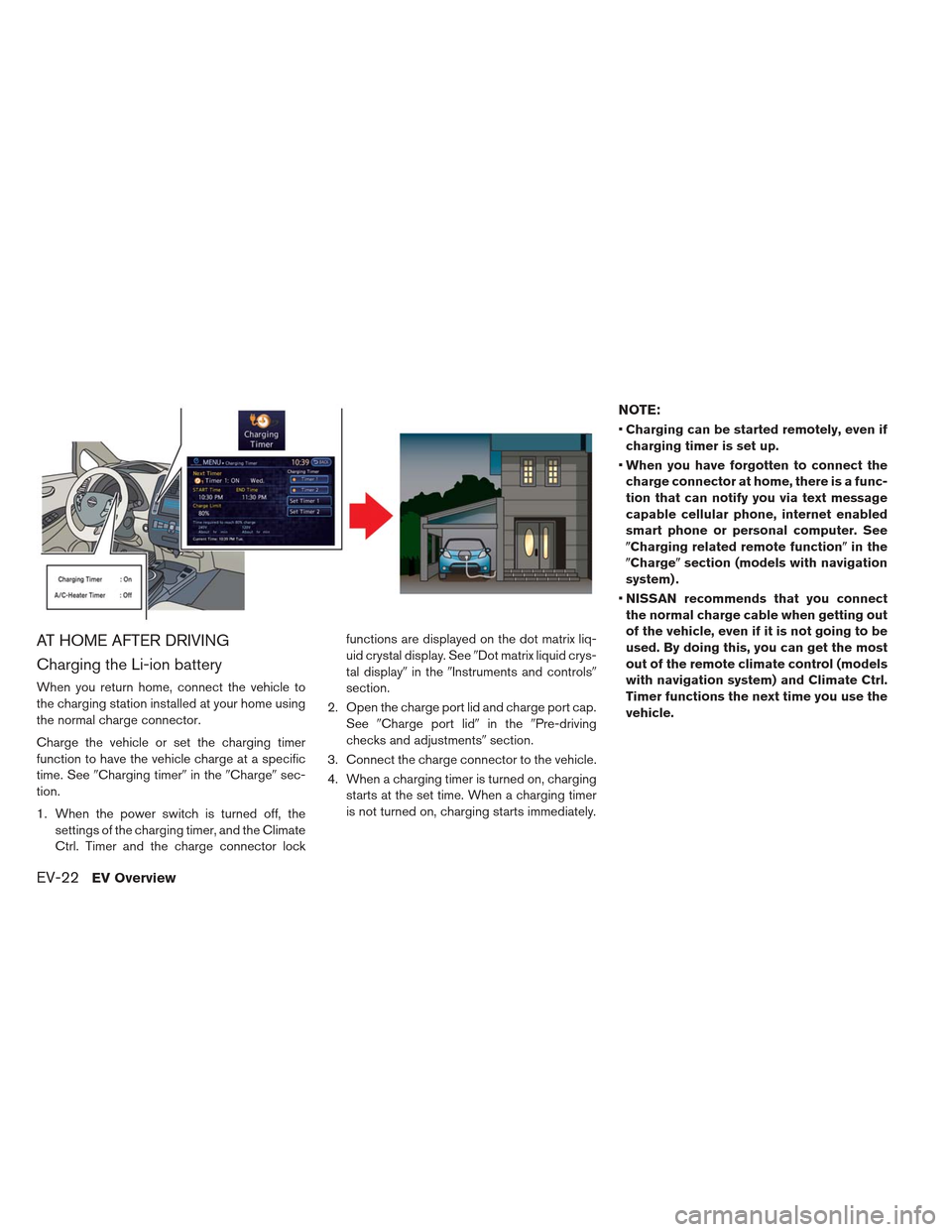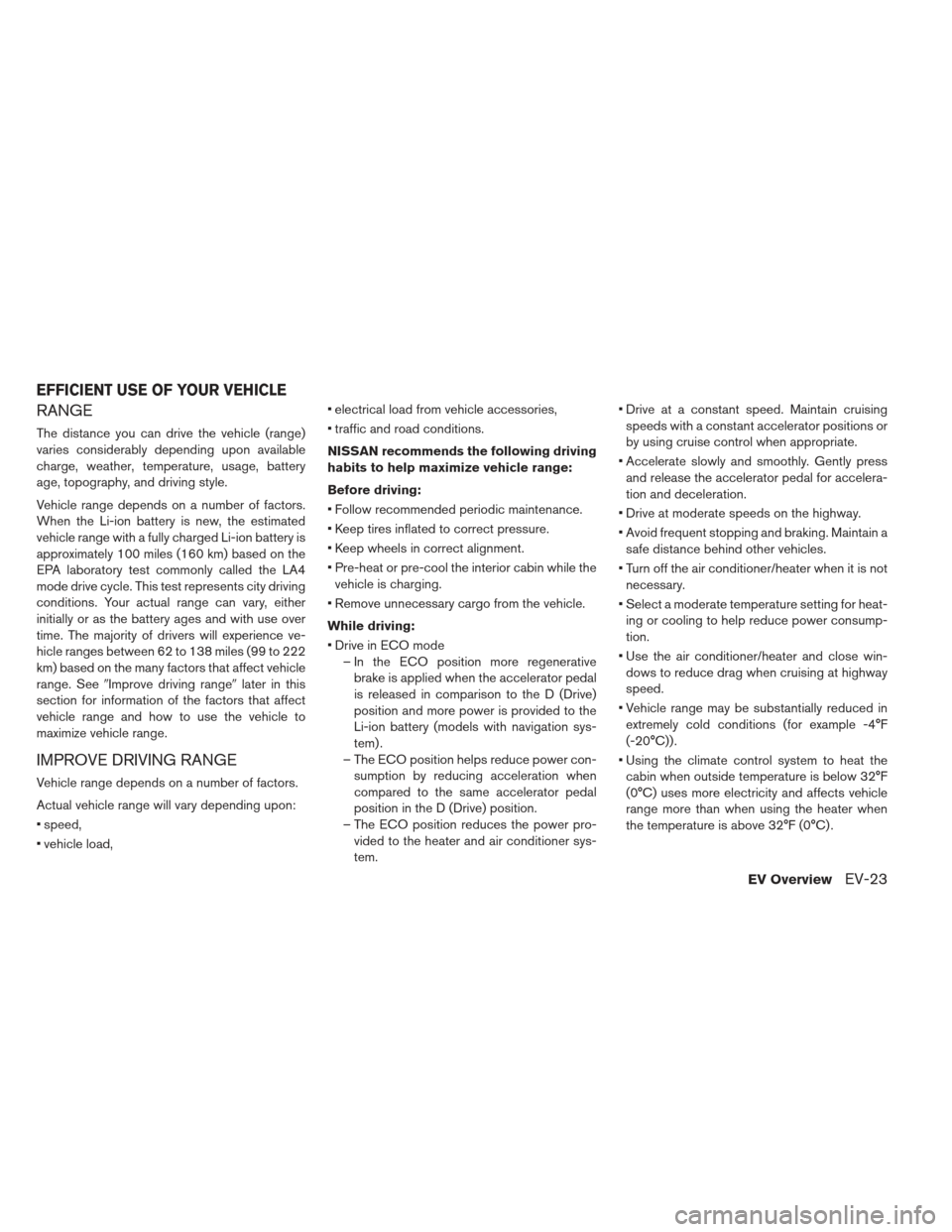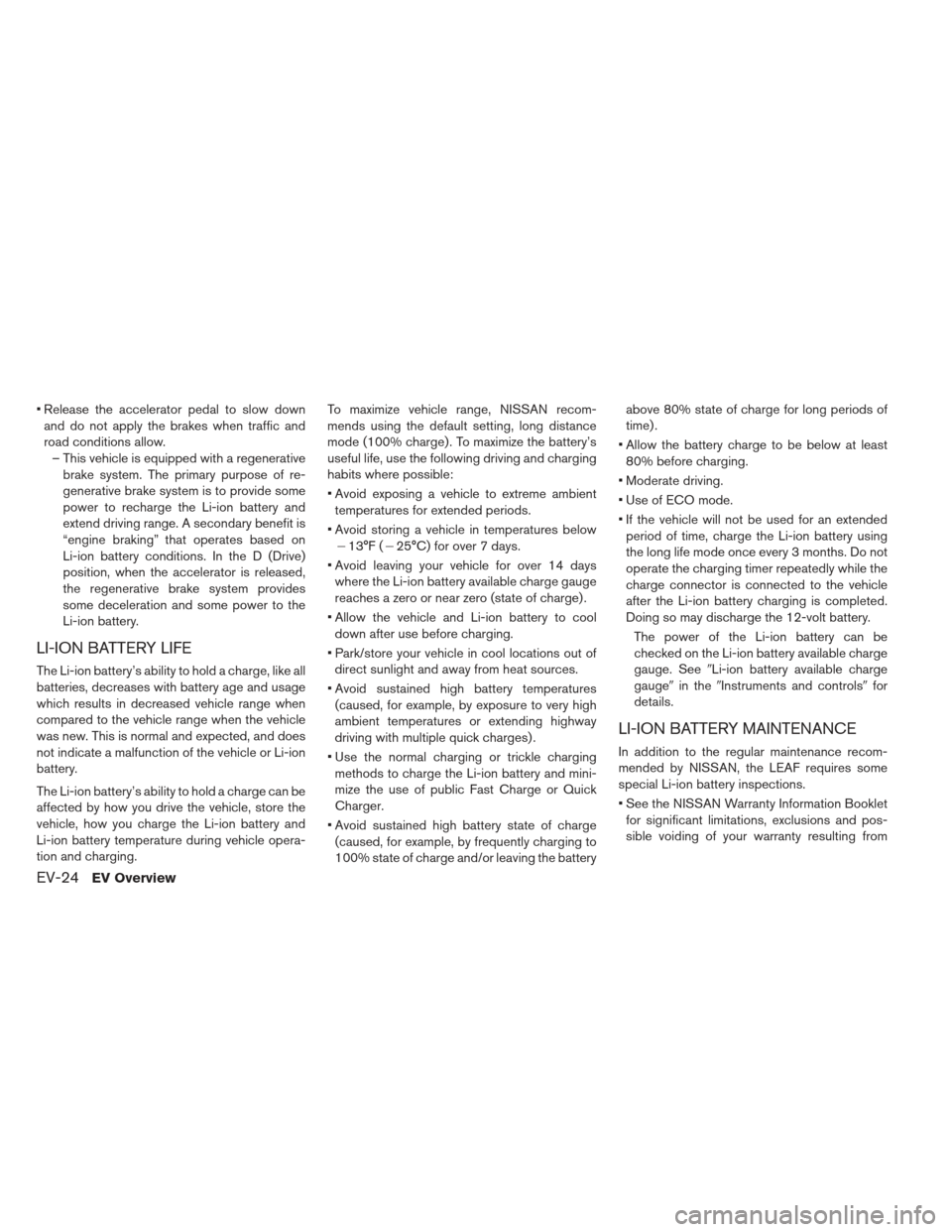Page 35 of 402
Notification of the Li-ion battery
warmer operation
You can be notified the Li-ion battery warmer
operation on the NISSAN CARWINGS Data
Center website via an internet enabled smart
phone or personal computer.When the power switch is in the OFF position
and charge connector is not connected, if the
Li-ion battery warmer starts or stops, it notifies
you to connect the charger to the vehicle.
See LEAF Navigation System Owner’s Manual.
EV-16EV Overview
Page 36 of 402

STARTING YOUR VEHICLE
1. Depress the brake pedal.
2. Press the power switch.
3. Check that the READY to drive indicator lightilluminates and the start up sound is audible.
See �Ready to drive indicator light� in the
�Instruments and controls� section.
4. For models with navigation system: If route guidance is necessary, enter the destination
in the navigation system. See LEAF Naviga-
tion System Owner’s Manual. 5. Check the Li-ion battery level and the esti-
mated driving range shown on the meter. See
�Driving range� in the�Instruments and con-
trols� section.
NOTE:
Before driving, compare the driving dis-
tance to the destination displayed on the
navigation screen with the estimated driv-
ing range shown on the meter. Determine
if it will be necessary to charge the Li-ion
battery before or while driving to your
planned destination (models with naviga-
tion system) .
If it is necessary to charge the Li-ion bat-
tery, use the navigation system to search
for available charging stations on your
planned driving route (models with navi-
gation system) .
EV OverviewEV-17
Page 39 of 402
If the low battery charge warning light
illuminates, the Li-ion battery charge is too low for
travel. See�Empty light� in the�Instruments and
controls� section. Charge the Li-ion battery as
soon as possible.
EV-20EV Overview
Page 40 of 402
Parking the vehicle
1. When stopping the vehicle, push the P (Park)position switch on the selector lever while
depressing the brake pedal. Confirm that the
vehicle is in the P (Park) position by checking
the shift indicator located near the selector
lever or on the dot matrix liquid crystal display. 2. Apply the parking brake.
3. Push the power switch to the OFF position.
4. If a parking lot is equipped with charging
facilities, charge the Li-ion battery as neces-
sary. See �Charge�section.
EV OverviewEV-21
Page 41 of 402

AT HOME AFTER DRIVING
Charging the Li-ion battery
When you return home, connect the vehicle to
the charging station installed at your home using
the normal charge connector.
Charge the vehicle or set the charging timer
function to have the vehicle charge at a specific
time. See�Charging timer� in the�Charge� sec-
tion.
1. When the power switch is turned off, the settings of the charging timer, and the Climate
Ctrl. Timer and the charge connector lock functions are displayed on the dot matrix liq-
uid crystal display. See
�Dot matrix liquid crys-
tal display� in the�Instruments and controls�
section.
2. Open the charge port lid and charge port cap. See �Charge port lid� in the�Pre-driving
checks and adjustments� section.
3. Connect the charge connector to the vehicle.
4. When a charging timer is turned on, charging starts at the set time. When a charging timer
is not turned on, charging starts immediately.
NOTE:
Charging can be started remotely, even if
charging timer is set up.
When you have forgotten to connect the
charge connector at home, there is a func-
tion that can notify you via text message
capable cellular phone, internet enabled
smart phone or personal computer. See
�Charging related remote function� in the
�Charge� section (models with navigation
system) .
NISSAN recommends that you connect
the normal charge cable when getting out
of the vehicle, even if it is not going to be
used. By doing this, you can get the most
out of the remote climate control (models
with navigation system) and Climate Ctrl.
Timer functions the next time you use the
vehicle.
EV-22EV Overview
Page 42 of 402

RANGE
The distance you can drive the vehicle (range)
varies considerably depending upon available
charge, weather, temperature, usage, battery
age, topography, and driving style.
Vehicle range depends on a number of factors.
When the Li-ion battery is new, the estimated
vehicle range with a fully charged Li-ion battery is
approximately 100 miles (160 km) based on the
EPA laboratory test commonly called the LA4
mode drive cycle. This test represents city driving
conditions. Your actual range can vary, either
initially or as the battery ages and with use over
time. The majority of drivers will experience ve-
hicle ranges between 62 to 138 miles (99 to 222
km) based on the many factors that affect vehicle
range. See�Improve driving range� later in this
section for information of the factors that affect
vehicle range and how to use the vehicle to
maximize vehicle range.
IMPROVE DRIVING RANGE
Vehicle range depends on a number of factors.
Actual vehicle range will vary depending upon:
speed,
vehicle load, electrical load from vehicle accessories,
traffic and road conditions.
NISSAN recommends the following driving
habits to help maximize vehicle range:
Before driving:
Follow recommended periodic maintenance.
Keep tires inflated to correct pressure.
Keep wheels in correct alignment.
Pre-heat or pre-cool the interior cabin while the
vehicle is charging.
Remove unnecessary cargo from the vehicle.
While driving:
Drive in ECO mode – In the ECO position more regenerativebrake is applied when the accelerator pedal
is released in comparison to the D (Drive)
position and more power is provided to the
Li-ion battery (models with navigation sys-
tem) .
– The ECO position helps reduce power con- sumption by reducing acceleration when
compared to the same accelerator pedal
position in the D (Drive) position.
– The ECO position reduces the power pro- vided to the heater and air conditioner sys-
tem. Drive at a constant speed. Maintain cruising
speeds with a constant accelerator positions or
by using cruise control when appropriate.
Accelerate slowly and smoothly. Gently press and release the accelerator pedal for accelera-
tion and deceleration.
Drive at moderate speeds on the highway.
Avoid frequent stopping and braking. Maintain a safe distance behind other vehicles.
Turn off the air conditioner/heater when it is not necessary.
Select a moderate temperature setting for heat- ing or cooling to help reduce power consump-
tion.
Use the air conditioner/heater and close win- dows to reduce drag when cruising at highway
speed.
Vehicle range may be substantially reduced in extremely cold conditions (for example -4°F
(-20°C)) .
Using the climate control system to heat the cabin when outside temperature is below 32°F
(0°C) uses more electricity and affects vehicle
range more than when using the heater when
the temperature is above 32°F (0°C) .
EFFICIENT USE OF YOUR VEHICLE
EV OverviewEV-23
Page 43 of 402

Release the accelerator pedal to slow downand do not apply the brakes when traffic and
road conditions allow. – This vehicle is equipped with a regenerative brake system. The primary purpose of re-
generative brake system is to provide some
power to recharge the Li-ion battery and
extend driving range. A secondary benefit is
“engine braking” that operates based on
Li-ion battery conditions. In the D (Drive)
position, when the accelerator is released,
the regenerative brake system provides
some deceleration and some power to the
Li-ion battery.
LI-ION BATTERY LIFE
The Li-ion battery’s ability to hold a charge, like all
batteries, decreases with battery age and usage
which results in decreased vehicle range when
compared to the vehicle range when the vehicle
was new. This is normal and expected, and does
not indicate a malfunction of the vehicle or Li-ion
battery.
The Li-ion battery’s ability to hold a charge can be
affected by how you drive the vehicle, store the
vehicle, how you charge the Li-ion battery and
Li-ion battery temperature during vehicle opera-
tion and charging. To maximize vehicle range, NISSAN recom-
mends using the default setting, long distance
mode (100% charge) . To maximize the battery’s
useful life, use the following driving and charging
habits where possible:
Avoid exposing a vehicle to extreme ambient
temperatures for extended periods.
Avoid storing a vehicle in temperatures below �13°F (�25°C) for over 7 days.
Avoid leaving your vehicle for over 14 days where the Li-ion battery available charge gauge
reaches a zero or near zero (state of charge) .
Allow the vehicle and Li-ion battery to cool down after use before charging.
Park/store your vehicle in cool locations out of direct sunlight and away from heat sources.
Avoid sustained high battery temperatures (caused, for example, by exposure to very high
ambient temperatures or extending highway
driving with multiple quick charges) .
Use the normal charging or trickle charging methods to charge the Li-ion battery and mini-
mize the use of public Fast Charge or Quick
Charger.
Avoid sustained high battery state of charge (caused, for example, by frequently charging to
100% state of charge and/or leaving the battery above 80% state of charge for long periods of
time) .
Allow the battery charge to be below at least 80% before charging.
Moderate driving.
Use of ECO mode.
If the vehicle will not be used for an extended period of time, charge the Li-ion battery using
the long life mode once every 3 months. Do not
operate the charging timer repeatedly while the
charge connector is connected to the vehicle
after the Li-ion battery charging is completed.
Doing so may discharge the 12-volt battery.
The power of the Li-ion battery can be
checked on the Li-ion battery available charge
gauge. See �Li-ion battery available charge
gauge� in the�Instruments and controls� for
details.
LI-ION BATTERY MAINTENANCE
In addition to the regular maintenance recom-
mended by NISSAN, the LEAF requires some
special Li-ion battery inspections.
See the NISSAN Warranty Information Booklet for significant limitations, exclusions and pos-
sible voiding of your warranty resulting from
EV-24EV Overview
Page 44 of 402
failure to have these necessary inspections, re-
pairs and/or adjustments performed.
See the NISSAN Service and Maintenance Guide for a detailed explanation of the Li-ion
battery inspection and intervals.METERS AND INDICATORS
The vehicle has two displays to provide informa-
tion regarding vehicle operation:
Upper display
Lower display
Upper display
Master warning lights:
The master warning lights are located in the
upper display.
The master warning lights illuminate when any
warning lights or indicators illuminate in the lower
display or when messages are displayed on the
dot matrix liquid crystal display.
For additional information, see �Master warning
light� in the �Instruments and controls� section.
EV UNIQUE INFORMATION
EV OverviewEV-25